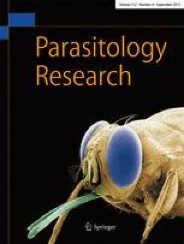Evaluation of the immune protective efects of rEmMIC2 and rEmMIC3 from Eimeria magna in rabbits
Hao Chen , Jiayan Pu, Jie Xiao, Xin Bai, Ruoyu Zheng, Xiaobin Gu, Yue Xie, Ran He, Jing Xu, Bo Jing, Xuerong Peng, Yongjun Ren, Guangyou Yang

Abstract
Eimeria magna is a common pathogen in rabbits, which results in lethargy, weight loss, diarrhea, and even death in severe cases after infection. The current method for preventing rabbit coccidiosis is to add anticoccidial drugs to the diet. However, there are many concerns about drug resistance and drug residues. In our study, the rEmMIC2 and rEmMIC3 proteins were cloned and expressed to evaluate potential as recombinant subunit vaccine candidate antigens. The protective effects of rEmMIC2 and rEmMIC3 were evaluated by the relative weight gain ratio, oocyst decrease rate, anticoccidial index, feed conversion ratio, pathological alterations, clinical symptoms, specific IgG antibody, and cytokine levels in rabbits. The molecular weights of rEmMIC2 and rEmMIC3 were 18.69 kDa and 17.47 kDa, respectively. After the coccidia challenge, the control groups showed anorexia and soft poop, whereas the experimental group showed few anorexia symptoms. Significantly different from the control group, the relative weight gain ratios of the immunized rEmMIC2 and rEmMIC3 groups were 78.37% and 75.29%, respectively, and the oocyst reduction was 77.95% and 76.09%, respectively, and the anticoccidial index was 171.12 and 169.29, respectively. IgG antibody, IFN-γ, IL-4, IL-10, and IL-17 levels were significantly increased in the experimental group. The results showed that rEmMIC2 and rEmMIC3 have potential as vaccine candidate antigens.
Keywords: Candidate antigens; Eimeria magna; Rabbit; rEmMIC2; rEmMIC3.
© 2022. The Author(s), under exclusive licence to Springer-Verlag GmbH Germany, part of Springer Nature.
Citation: Chen H, Pu J, Xiao J, Bai X, Zheng R, Gu X, Xie Y, He R, Xu J, Jing B, Peng X, Ren Y, Yang G. Evaluation of the immune protective effects of rEmMIC2 and rEmMIC3 from Eimeria magna in rabbits. Parasitol Res. 2023 Feb;122(2):661-669. doi: 10.1007/s00436-022-07774-3.
Read full text: https://www.ncbi.nlm.nih.gov/pmc/articles/PMC9792316/

